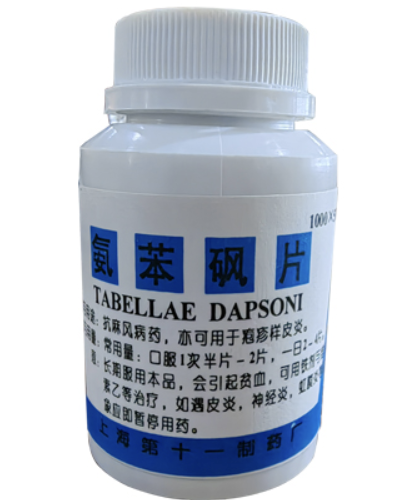Dapson tablets
Effects and efficacy: This product is used in combination with other anti-leprosy drugs to treat various types of leprosy and herpetiform dermatitis caused by Mycobacterium leprae. It is also used to treat pustular dermatosis, pemphigoid, necrotizing pyoderma, relapsing polychondritis, annular granuloma, certain skin lesions of systemic lupus erythematosus, actinomycetous mycotic disease, acne vulgaris, psoriasis, and herpes zoster. It can be used in combination with trimethoprim to treat Pneumocystis carinii infection. It can be used in combination with pyrimethamine to prevent chloroquine-resistant malaria; it can also be used in combination with pyrimethamine and chloroquine to prevent vivax malaria.
Usage and dosage: It is taken orally to inhibit leprosy, and is used in combination with one or more other anti-leprosy drugs. Adults take 50-100 mg once a day; or 0.9-1.4 mg/kg per day according to body weight, once a day, and the maximum dose is 200 mg per day. You can take 12.5-25 mg orally at the beginning, and then gradually increase the dose to 100 mg per day. Children take 0.9-1.4 mg/kg once a day according to body weight. Because this product has an accumulation effect, stop taking it for 1 day after taking it for 6 days, and stop taking it for 2 weeks after taking it for 10 weeks. For the treatment of herpetiform dermatitis, adults start taking it orally at 50 mg per day. If the symptoms are not completely suppressed, the daily dose can be increased to 300 mg. The maximum dose for adults is 500 mg per day, and it will be reduced to the minimum effective maintenance dose after the condition is controlled. Children start taking it at 2 mg/kg per day according to body weight. If the symptoms are not completely suppressed, the dose can be gradually increased and reduced to the minimum effective dose after the condition is controlled. For the prevention of malaria, this product 100 mg is combined with 12.5 mg of pyrimethamine, taken once a day, and taken once every 7 days. Precautions for follow-up examinations Routine blood count: once a week before medication and in the first month of treatment, once a month thereafter, for 6 consecutive months, and once every six months thereafter. G-6PD determination: This product should be used with caution if you are G-6PD deficient. Liver function tests (such as urine bilirubin and aspartate aminotransferase assay): Patients should be tested if they have anorexia, nausea or vomiting during treatment. If there is liver damage, this product should be discontinued. Renal function test: Patients with renal impairment should have their renal function tested regularly during treatment and the dose adjusted appropriately. Primary and secondary dapsone-resistant Mycobacterium leprae strains are increasing. This product should not be used alone to treat leprosy. It should be used in combination with rifampicin, clofazimine, ethionamide, propylthionamide, ofloxacin, minocycline, clarithromycin, etc. The course of treatment is 6 months for those with negative skin lesions, and at least 2 years for those with positive skin lesions or until the bacteria turn negative. The treatment of unspecified and tuberculoid leprosy needs to last for 3 years, type II leprosy needs 2 to 10 years, and tumor-type leprosy needs lifelong medication. The blood concentration of this product may be very low in patients with fast acetylation type, and the dose needs to be adjusted. The blood concentration of this product may be high in patients with slow acetylation type, and the dose also needs to be adjusted. Patients with impaired renal function need to reduce the dosage of the drug. If the creatinine clearance rate is lower than 4ml/min, the blood drug concentration needs to be measured. Patients with anuria should stop using this product. If new or toxic skin reactions occur during medication, this product should be discontinued immediately. However, it is not necessary to stop the drug when a leprosy reaction occurs. If severe “reversible” reactions (type I) or neuritis occur during treatment, high-dose corticosteroids should be used in combination.
Drug contraindications:
Allergic to this product is prohibited. Use with caution in patients with liver and kidney dysfunction
Related dosage forms:
Tablets, injection
Share:
Products
Our offers
Health Classification
Let us work together to protect precious health






























